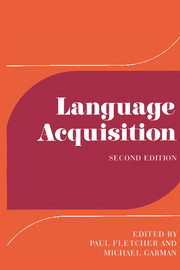Book contents
- Frontmatter
- Contents
- Contributors
- Preface
- Part I Contexts and determinants
- Part II The development of linguistic systems: phonology
- Introduction
- 7 Prespeech segmental feature development
- 8 Prosodic development
- 9 Early strategies for the perception and production of words and sounds
- 10 Phonological development: production
- 11 Speech perception and the emergent lexicon: an ethological approach
- 12 Phonological development: a crosslinguistic perspective
- Part III The development of linguistic systems: grammar
- Part IV Later language development
- Notes to chapters
- Bibliography and citation index
- General index
- Titles in the series
10 - Phonological development: production
Published online by Cambridge University Press: 05 June 2012
- Frontmatter
- Contents
- Contributors
- Preface
- Part I Contexts and determinants
- Part II The development of linguistic systems: phonology
- Introduction
- 7 Prespeech segmental feature development
- 8 Prosodic development
- 9 Early strategies for the perception and production of words and sounds
- 10 Phonological development: production
- 11 Speech perception and the emergent lexicon: an ethological approach
- 12 Phonological development: a crosslinguistic perspective
- Part III The development of linguistic systems: grammar
- Part IV Later language development
- Notes to chapters
- Bibliography and citation index
- General index
- Titles in the series
Summary
Introduction
Between the ages of 1;6 and 4;0 the young child undergoes considerable development in phonological ability. Starting with a small vocabulary of approximately 50 words, the child proceeds from single-word utterances of very simple phonological form (see Menyuk, Menn and Silber, ch. 9, this volume), to multiword utterances that are relatively high in intelligibility. Phonological ability improves through an increase in the ability to produce adult sounds and combine them into more complex phonological structures. Elsewhere (Ingram 1976a), I have referred to this stage as one in which children acquire ‘the phonology of simple morphemes’.
Years ago Jespersen (1922) noted the distinctness of this stage of phonological acquisition from the one that precedes it. In characterizing it, he emphasized the regularities that occur in the child's words (pp. 106–7):
As the child gets away from the peculiarities of his individual ‘little language’, his speech becomes more regular, and a linguist can in many cases see reasons for his distortions of normal words. When he replaces one sound by another there is always some common element in the formation of the two sounds … There is generally a certain system in the sound substitutions of children, and in many instances we are justified in speaking of ‘strictly observed sound-laws’.
For example, Jespersen mentioned the observation that children in different linguistic communities show a tendency to replace velar stops with alveolar ones. The child who says [tæt] for cat will also say [do] for go.
- Type
- Chapter
- Information
- Language AcquisitionStudies in First Language Development, pp. 223 - 239Publisher: Cambridge University PressPrint publication year: 1986
- 18
- Cited by



